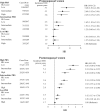Genetic Factors, Adherence to Healthy Lifestyle Behavior, and Risk of Invasive Breast Cancer Among Women in the UK Biobank
- PMID: 31899501
- PMCID: PMC7492765
- DOI: 10.1093/jnci/djz241
Genetic Factors, Adherence to Healthy Lifestyle Behavior, and Risk of Invasive Breast Cancer Among Women in the UK Biobank
Erratum in
-
Corrigendum: Genetic Factors, Adherence to Healthy Lifestyle Behavior, and Risk of Invasive Breast Cancer Among Women in the UK Biobank.J Natl Cancer Inst. 2020 Oct 1;112(10):1076. doi: 10.1093/jnci/djaa085. J Natl Cancer Inst. 2020. PMID: 32997741 Free PMC article. No abstract available.
Abstract
Background: Breast cancer is considered to result from a combination of genetic and lifestyle-related factors, but the degree to which an overall healthy lifestyle may attenuate the impact of multiple genetic variants on invasive breast cancer risk remains equivocal.
Methods: Using Cox proportional hazards regression models, we examined the association of a modified healthy lifestyle index (HLI) with risk of invasive breast cancer by genetic risk group among 146 326 women from the UK Biobank. We generated an HLI score based on a combination of diet, physical activity, smoking, alcohol consumption and anthropometry, and a polygenic risk score (PRS) using 304 breast cancer-associated genetic loci.
Results: Among premenopausal and postmenopausal women, a favorable lifestyle (highest tertile) was associated with 22% and 31% reductions in invasive breast cancer risk, respectively (hazard ratio [HR]high vs low = 0.78, 95% confidence interval [CI] = 0.64 to 0.94; HRhigh vs low = 0.69, 95% CI = 0.63 to 0.77, respectively), whereas a high PRS (highest tertile) was associated with more than a doubling in the risk in both groups. For premenopausal women, the greatest risk reduction in association with the HLI was seen among those with a high PRS (HRhigh vs low = 0.73, 95% CI = 0.75 to 0.95). In postmenopausal women, those with a favorable lifestyle had 30%, 29%, and 32% reductions in risk of invasive breast cancer in the low, intermediate, and high PRS groups, respectively (HRhigh vs low = 0.70, 95% CI = 0.56 to 0.88; HRhigh vs low = 0.71, 95% CI = 0.59 to 0.84; and HRhigh vs low = 0.68, 95% CI = 0.59 to 0.78, respectively). There was an additive but not multiplicative interaction between the HLI score and PRS for postmenopausal and, to a lesser extent, premenopausal women.
Conclusion: Our findings support the view that an overall healthy lifestyle may attenuate the impact of genetic factors on invasive breast cancer risk among women of European ancestry.
© The Author(s) 2020. Published by Oxford University Press. All rights reserved. For permissions, please email: journals.permissions@oup.com.
Figures


Comment in
-
Data Sharing for the Public Good.J Natl Cancer Inst. 2020 Sep 1;112(9):867-868. doi: 10.1093/jnci/djz242. J Natl Cancer Inst. 2020. PMID: 31899487 Free PMC article. No abstract available.
References
Publication types
MeSH terms
Grants and funding
LinkOut - more resources
Full Text Sources
Medical

